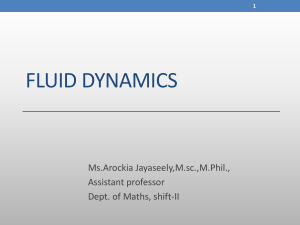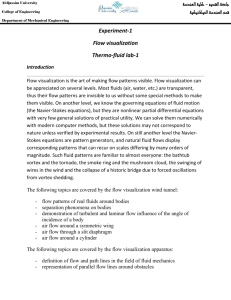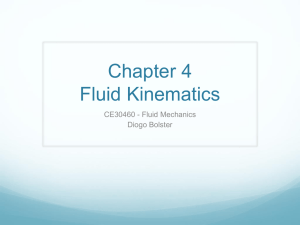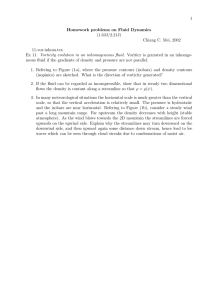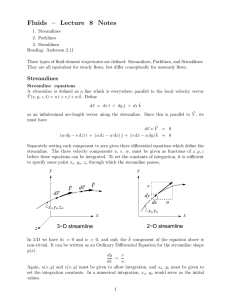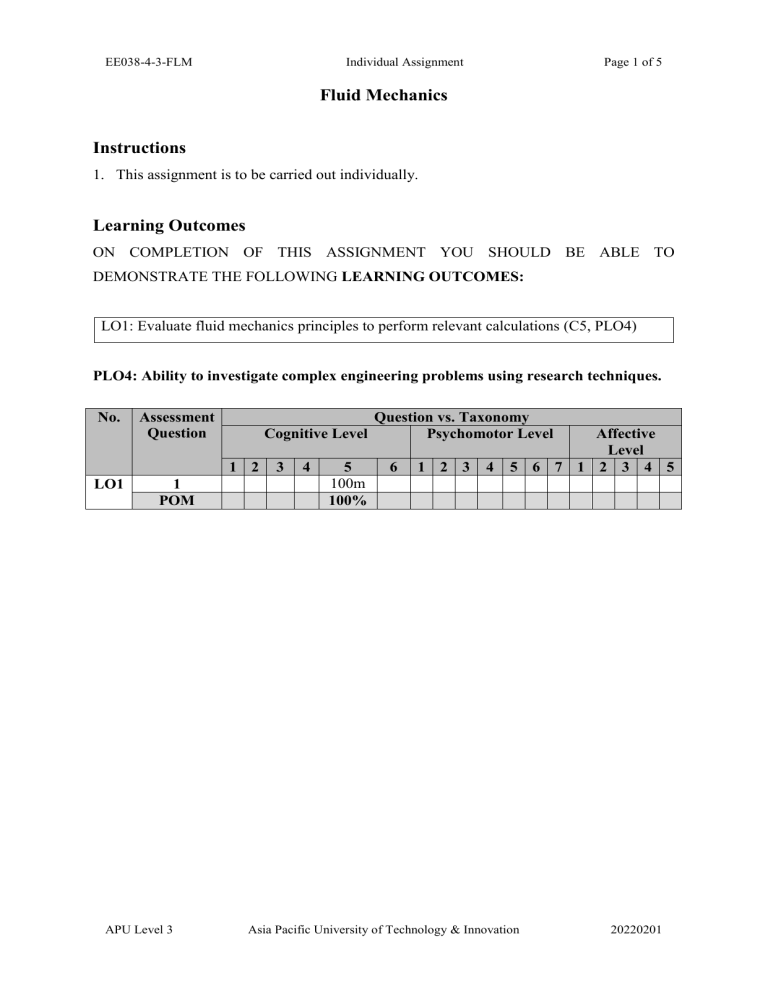
EE038-4-3-FLM Individual Assignment Page 1 of 5 Fluid Mechanics Instructions 1. This assignment is to be carried out individually. Learning Outcomes ON COMPLETION OF THIS ASSIGNMENT YOU SHOULD BE ABLE TO DEMONSTRATE THE FOLLOWING LEARNING OUTCOMES: LO1: Evaluate fluid mechanics principles to perform relevant calculations (C5, PLO4) PLO4: Ability to investigate complex engineering problems using research techniques. No. Assessment Question Cognitive Level 1 2 LO1 1 POM APU Level 3 3 4 5 100m 100% Question vs. Taxonomy Psychomotor Level 6 1 2 3 4 Affective Level 5 6 7 1 2 3 4 5 Asia Pacific University of Technology & Innovation 20220201 EE038-4-3-FLM Individual Assignment Page 2 of 5 A. Fluid Flow Visualization Fluid flow visualization is the art of making flow patterns visible. Most fluids (air, water, etc.) are transparent, thus their flow patterns are invisible to the naked eye without methods to make them this visible. Historically, such methods included experimental methods. With the development of computer models and computational fluid dynamics (CFD) simulating flow processes (e.g. the distribution of air-conditioned air in a new car), purely computational methods have been developed. In experimental fluid dynamics, flows are visualized by three methods: 1. Surface flow visualization: This reveals the flow streamlines in the limit as a solid surface is approached. Colored oil applied to the surface of a wind tunnel model provides one example (the oil responds to the surface shear stress and forms a pattern). 2. Particle tracer methods: Particles, such as smoke or microspheres, can be added to a flow to trace the fluid motion. The particles are illuminated with a sheet of laser light in order to visualize a slice of a complicated fluid flow pattern. 3. Optical methods: Some flows reveal their patterns by way of changes in their optical refractive index. These are visualized by optical methods known as the shadowgraph, schlieren photography, and interferometry. In scientific visualization flows are visualized with two main methods: 1. Analytical methods that analyse a given flow and show properties like streamlines, streaklines, and pathlines. The flow can either be given in a finite representation or as a smooth function. 2. Texture advection methods that "bend" textures (or images) according to the flow. As the image is always finite (the flow through could be given as a smooth function), these methods will visualize approximations of the real flow. Streamlines, streaklines and pathlines are field lines in a fluid flow. They differ only when the flow changes with time, that is, when the flow is not steady. Considering a velocity vector field in three-dimensional space in the framework of continuum mechanics, Streamlines are a family of curves that are instantaneously tangent to the velocity vector of the flow. These show the direction in which a massless fluid element will travel at any point in time. Streaklines are the loci of points of all the fluid particles that have passed continuously through a particular spatial point in the past. Dye steadily injected into the fluid at a fixed point extends along a streakline. APU Level 3 Asia Pacific University of Technology & Innovation 20220201 EE038-4-3-FLM Individual Assignment Page 3 of 5 Pathlines are the trajectories that individual fluid particles follow. These can be thought of as "recording" the path of a fluid element in the flow over a certain period. The direction the path takes will be determined by the streamlines of the fluid at each moment in time. B. Objective To evaluate the visualization effects of streamlines, streaklines and pathlines. C. Analyses Requirement Students are required to evaluate the visualization effects of streamlines, streaklines and pathlines based on following two dimensional velocity field equation ⃑ = (𝑢̅, 𝑣̅ ) = (0.6 + 0.8𝑥)𝑖 + (1.6 + 2.5𝑠𝑖𝑛(𝜔𝑡) − 0.8𝑦)𝑗 𝑉 Where the angular velocity, is equal to 2, 0 < x < 5 m, - 1 m < y < 5 m and 0 < t < 2 s. Other required parameters should be assumed appropriately and justified from the complex engineering perspectives. D. Report Writing A written report is required to be submitted. The report has to be neatly typed up with no hand-drawn figures or hand written equations. Figures that are taken using digital camera and reproduced in the report are strictly not allowed. The report should include, but not be limited to the following chapters: 1. Flow visualization methods 2. Determination of streamlines, pathlines and streaklines 3. Evaluation of the visualizations. 4. Discussion 5. Conclusion E. Tutor Assessment Students are required to do a short presentation of your investigation and have a question and answer (Q&A) session with the lecturer before the report is submitted. APU Level 3 Asia Pacific University of Technology & Innovation 20220201 EE038-4-3-FLM Individual Assignment Page 4 of 5 Grading Criteria Criteria Flow Visualization Methods (15%) [LO1-PO4] Determine streamlines, pathlines and streaklines with unclear assumptions. Evaluate briefly streamlines, pathlines and streaklines according to their differences. Appraisal done on the results obtained and identified the main ideas with very poor discussion. Determination of streamlines, pathlines and streaklines (30%) [LO1-PO4] Evaluation of the Visualizations (20%) [LO1-PO4] Discussion (10%) [LO1-PO4] Fail Explain with very poor and unrelated facts on the visualization methods. APU Level 3 Marginal Fail Explain with poor facts about the visualization methods and barely related to the appropriate engineering principles associated with the method. Determine streamlines, pathlines and streaklines without proper assumptions. Pass Explain briefly about the visualization methods and related to appropriate engineering principles associated with the methods generally. Credit Explain sufficiently all the visualization methods and related to the appropriate engineering principles associated with methods. Distinction Explain in detail all the visualization methods and related to the appropriate engineering principles associated with the process accurately. Determine streamlines, pathlines and streaklines according to proper assumptions with justifications based on complex engineering considerations. Evaluate streamlines, pathlines and streaklines according to their differences, advantages and disadvantages in visualizing complex engineering fluid flow. Appraisal done on the results obtained and identified the main ideas with excellent discussion. Determine streamlines, pathlines and streaklines according to proper assumptions. Determine streamlines, pathlines and streaklines according to proper assumptions with justifications. Evaluate streamlines, pathlines and streaklines according to their differences. Evaluate streamlines, pathlines and streaklines according their differences, advantages and disadvantages. Evaluate streamlines, pathlines and streaklines according to their differences, advantages and disadvantages in visualizing common fluid flow problems. Appraisal done on the results obtained and identified the main idea with poor discussion. Appraisal done on the results obtained and identified the main ideas with average discussion. Appraisal done on the results obtained and identified the main ideas with good discussion. Asia Pacific University of Technology & Innovation 20220201 EE038-4-3-FLM Page 5 of 5 Evaluation outcomes are not concluded or not related as a solution to the complex engineering problem. Evaluation outcomes are poorly concluded as a solution to the complex engineering problem. Evaluation outcomes are concluded with one or two pints as an average solution to the complex engineering problem. Evaluation outcomes are sufficiently concluded but some points unrelated to the solution to the complex engineering problem. Evaluation outcomes are accurately concluded as a solution to the complex engineering problem. Evaluation outcomes are not presented, explained and justified as an appraisal to the visualization methods. Evaluation outcomes are presented, explained and justified with poor ability to provide as an appraisal to the visualization methods. Evaluation outcomes are presented, explained and justified with an average ability to provide an appraisal to the visualization methods. Evaluation outcomes are presented, explained and justified with good ability to provide as an appraisal to the visualization methods.. Evaluation outcomes are presented, explained and justified with excellent ability to provide as an appraisal to the visualization methods. Conclusion (5%) [LO1-PO4] Tutor Assessment (20%) [LO4-PO2] Individual Assignment APU Level 3 Asia Pacific University of Technology & Innovation 20220201
